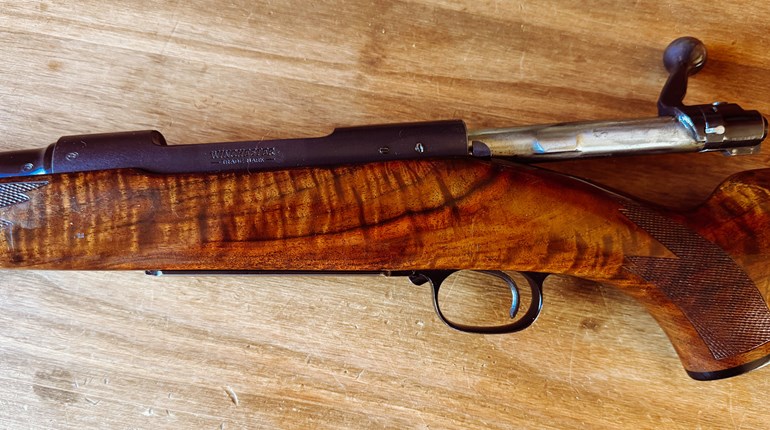
Last issue, we discussed power factor and how it impacts various handgun cartridges in competition. However, if you do not shoot competitively, you probably don’t care about power factor. On the other hand, if you’re carrying a handgun for protection, kinetic energy is something you should be interested in. Kinetic energy is a factor of ballistics that most shooters reference when comparing cartridge or load performance. I wrote about it, and tried to explain it, in this column 13 years ago. Either not everyone got the message, or I did not explain it very well. Based on communications with other shooters, I think it’s still mostly misunderstood. So, let’s try again.
Kinetic energy is the form of energy that an object possesses due to motion. When calculating the kinetic energy of a bullet—the object in motion—we multiply its weight in grains by the square of its velocity in fps, and then we divide the product by 450,400. For example, if we are talking about a 230-grain bullet traveling at 850 fps, it would have 369 ft.-lbs. of kinetic energy.
Using the equation: kinetic energy = (bullet weight in grains x velocity in fps2)/450,400, we find this example to be: (230 grains x 850 fps2)/450,400 = 369 ft.-lbs.
That’s easy enough to compute, but what exactly are foot-pounds? A foot-pound is a unit of energy equal to the work done by a force of one pound acting over one foot of distance. In bullet impacts, it reflects total energy available to do work on a target. In our example above, where that .45 ACP bullet can have 369 ft.-lbs. of kinetic energy, some shooters wonder why that bullet would not knock a person down—or at least substantially move them—when they’re hit. Well, the answer is as complicated as it is simple. Kinetic energy can be transferred from one object to another, typically through the process of work, where the moving object does work on a stationary object. So, where does all the bullet’s kinetic energy go?
Well, let’s look at a bullet that impacts a swinging steel plate. Some of the bullet’s kinetic energy is used to do work on the bullet and target materials, resulting in bullet deformation/expansion, heat and sound, along with minimal alteration to the face of the steel plate. The less the plate moves—because of the weight of the plate—the more the bullet deforms, and the more heat and sound that’s created. The more energy lost to deformation, heat and sound, the less that’s available to move the plate.
When shooting ballistic-test mediums like 10-percent ordnance gelatin (or when shooting bad guys), some of the bullet’s kinetic energy is used to do work that causes deformation, tissue damage and penetration. And in some cases, if the bullet exits, it retains some of the kinetic energy it had to begin with. When shooters compare handgun loads with different kinetic energies, their common assumption is—usually—that the load with the most kinetic energy will be the best stopper. But, all kinetic energy really conveys is capability, not results, because bullets of different calibers and construction work in different ways.
Some will argue the kinetic-energy formula weighs velocity too heavily—because it’s squared—in the kinetic-energy calculation. If you’re trying to predict a bullet’s potential lethality (its ability to damage tissues, penetrate or to stop a bad guy), that might be true. But, what you must remember with kinetic energy is it is not a reflection of lethality or stopping power. Things with kinetic energy can do work, the question is how much work and what types of work will they do?
I prefer to look at kinetic energy like I look at the horsepower of an automobile. Two different vehicles with the same horsepower can perform very differently. This is because the gear box, differential and tires, along with the weight of the automobile, all play into the equation of how it uses its available horsepower. With kinetic energy, the weight of the bullet, along with its type of construction and the materials from which it’s built all determine the transfer or conversion of kinetic energy when the bullet impacts a steel plate, a bad guy or a watermelon.
As an example, let’s look at two handgun bullets: a 124-grain 9 mm and a 230-grain .45 ACP. They could both have the same kinetic energy if the 124-grain bullet was traveling at 1,157 fps and the 230-grain bullet was traveling at 850 fps. However, we know both will not work the same, because kinetic energy does not tell us how far either bullet will move a steel plate, how deep it will penetrate or how much tissue it might damage along the way. You could make one bullet out of chocolate and the other out of lead. One might work great on bad guys while the other would only be good for Easter bunnies.
So, why do we even bother with kinetic energy in ballistic charts? For the same reason you look at a car’s horsepower specs. From a defensive-handgun point-of-view, more kinetic energy is better, but what’s more important is the work the kinetic energy facilitates.





































